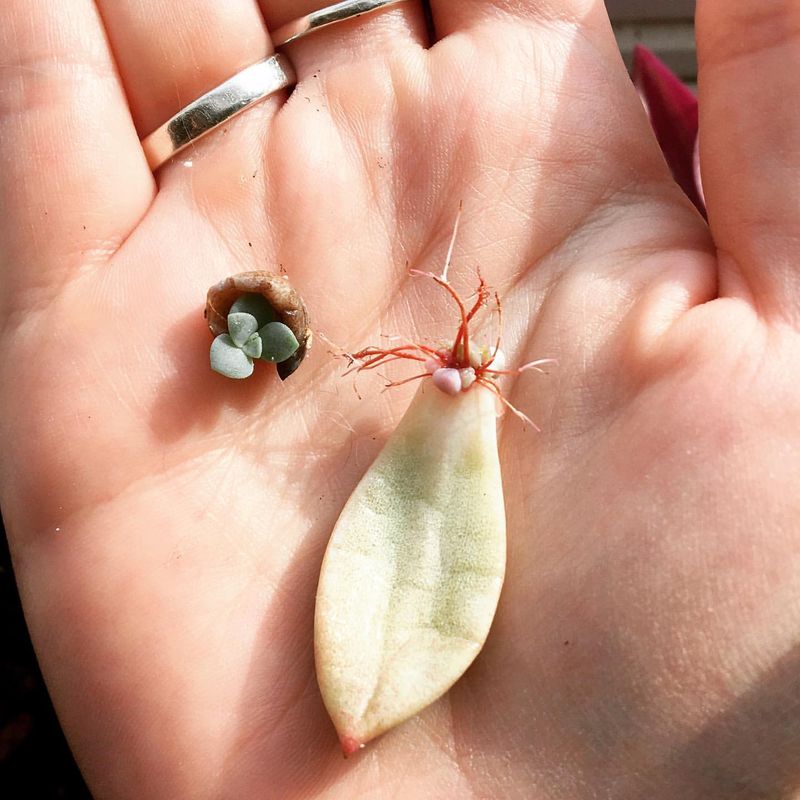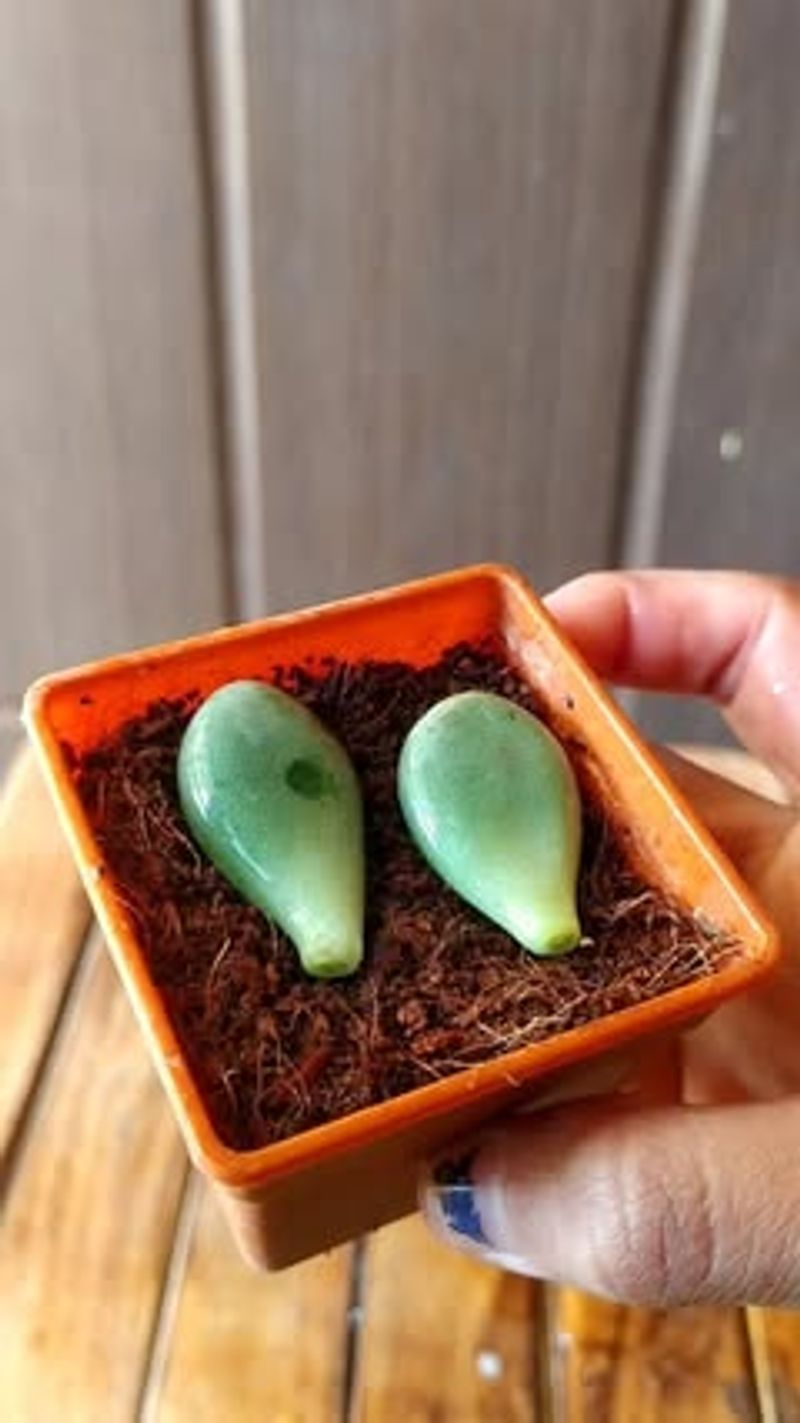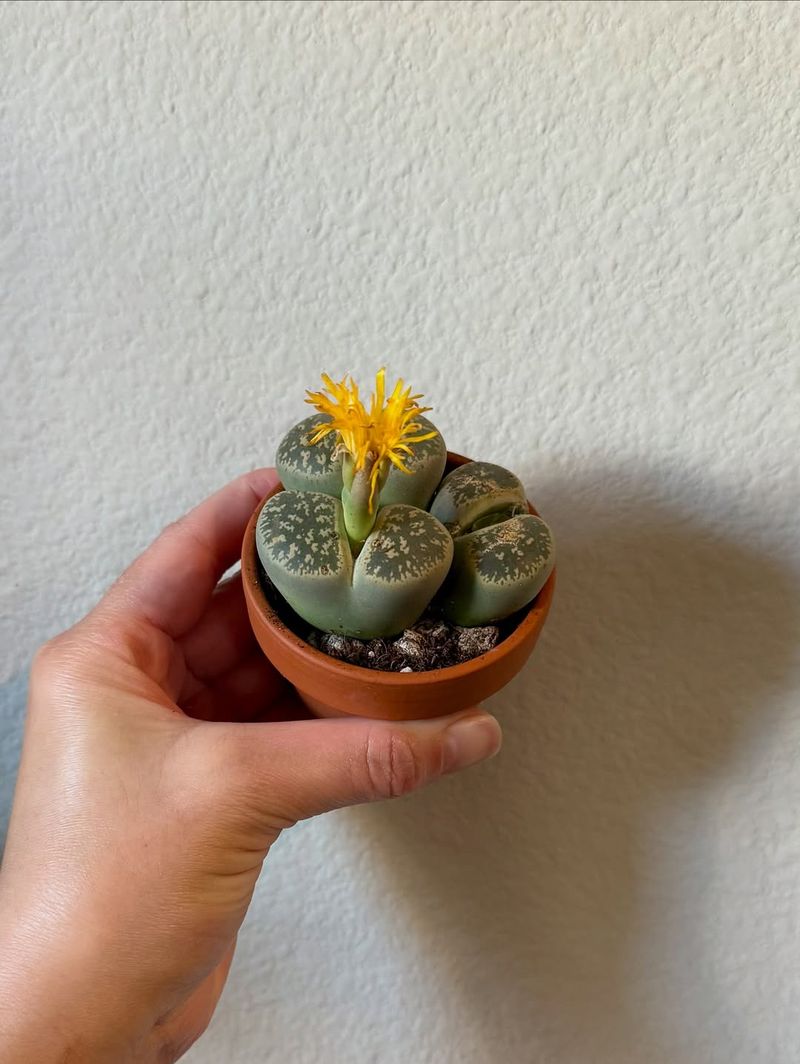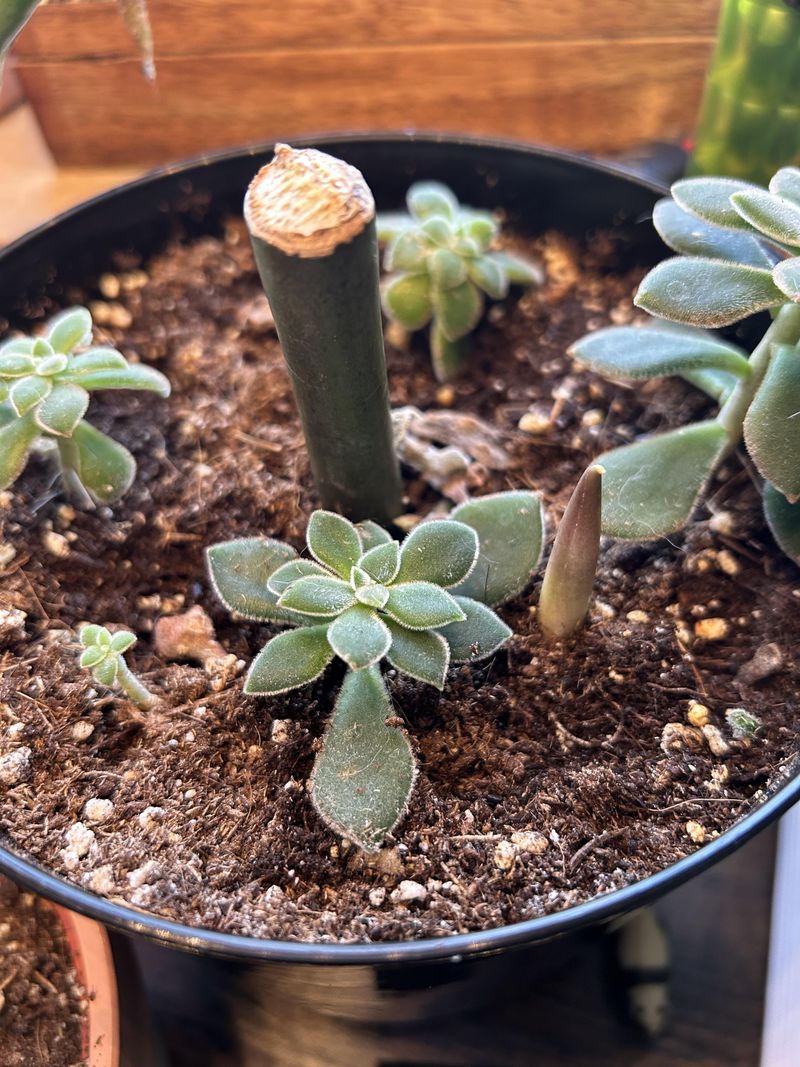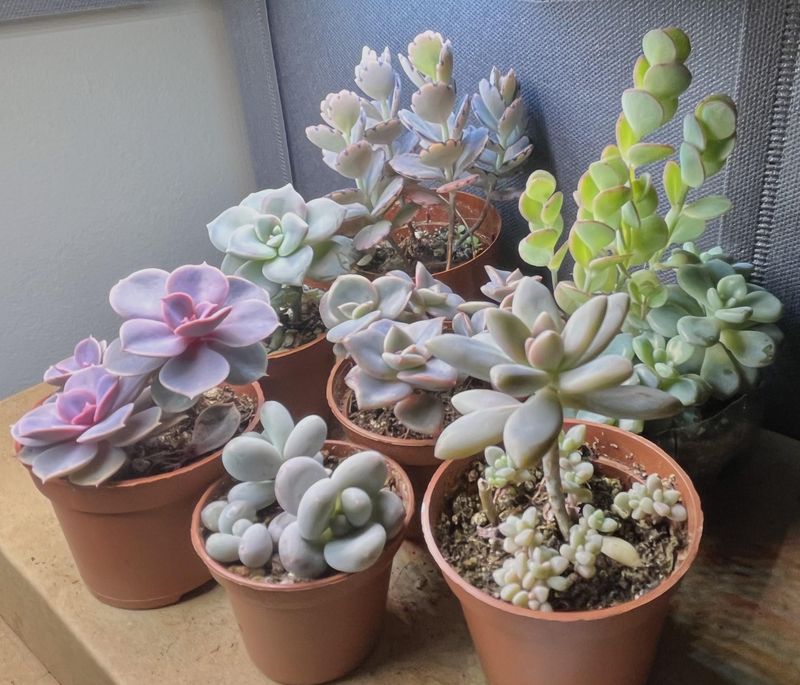A single leaf slips off the edge of my succulent, and I spot an opportunity instead of a setback.
I once tossed those fallen pieces without a second thought, but a simple method changed my whole approach.
A healthy leaf holds quiet potential, and with the right touch it sends out roots and starts a brand-new plant before I know it.
I watch tiny buds form, small rosettes take shape, and a full collection expand almost out of nowhere.
This trick turns one pot into many, saves money, and gives me a steady supply of fresh plants for any spot in my home.
Pick Healthy, Plump Leaves From The Base
You know that feeling when you’re choosing the best apple at the store?
Picking succulent leaves is kind of like that.
You want ones that look full of life, firm to the touch, and free from any weird spots or wrinkles.
Thin or damaged leaves just won’t have the energy to grow new roots and baby plants.
Always grab leaves from the lower part of the plant where they’re most mature.
Gently wiggle the leaf side to side until it comes off cleanly with the entire base attached.
If you snap it halfway or leave part behind, it probably won’t work.
A clean break is everything here.
The leaf needs that little attachment point where it connected to the stem because that’s where all the magic happens.
Think of it as the leaf’s battery pack for starting new growth.
Let The Leaves Callus Over Before Planting
Here’s where a lot of people mess up, and honestly, I did too when I first started.
You might think you should plant the leaf right away, but that’s actually a recipe for rot.
Freshly picked leaves are like open wounds and need time to heal before they touch any soil or water.
Place your leaves on a dry plate or tray somewhere with good air flow, away from direct sunlight.
Just let them sit there for about two to five days.
You’ll notice the end where it broke off will dry out and form a hard, slightly crusty layer.
This callus is your green light to move forward.
It protects the leaf from bacteria and fungus that love moist environments.
Skipping this step is probably the number one reason leaf propagation fails, so be patient and give them time to seal up properly.
Use Well-Draining Soil Mix For Success
Regular potting soil is way too heavy for succulent leaves trying to grow roots.
It holds onto water like a sponge, and your leaves will just sit there getting mushy instead of sprouting.
You need something light and gritty that lets water drain through quickly while still giving baby roots something to grab onto.
Look for cactus or succulent soil mix at any garden center, or make your own by mixing regular potting soil with coarse sand and perlite.
The ratio I like is about half potting soil and half gritty stuff.
It should feel almost dry and crumbly in your hands.
Spread a thin layer of this mix in a shallow tray or pot.
You don’t need much depth since the roots will be tiny at first.
Good drainage keeps things from getting too wet and gives your leaves the best chance at growing strong, healthy babies.
Lay Leaves Flat On Top Of The Soil
This part feels almost too easy, but that’s the beauty of it.
Once your leaves have callused and your soil is ready, simply place each leaf flat on top of the soil surface.
Don’t bury them, don’t stick them in at an angle, just lay them down gently like you’re tucking them into bed.
The callused end should be touching or very close to the soil, but the rest of the leaf can just rest there.
Some people like to arrange them in neat rows, others just scatter them around.
Either way works perfectly fine as long as they have contact with the soil.
Roots will naturally grow downward into the soil, and the baby plant will sprout from that same spot.
Burying the leaf can actually trap moisture against it and cause problems.
Keeping things simple and surface-level is really all you need to do at this stage.
Mist Lightly But Don’t Overwater
Watering propagating leaves is totally different from watering established plants.
These little guys don’t have roots yet, so they can’t drink up water the normal way.
Too much moisture will make them rot before they ever get a chance to grow.
I learned this the hard way with my first batch, and it was heartbreaking.
Use a spray bottle to give the soil a light misting every few days, just enough to keep it barely damp.
You’re not trying to soak anything, just provide a tiny bit of humidity.
The leaves themselves have stored water inside, so they’re not desperate for more.
Once you see roots starting to grow, you can mist a bit more often, maybe every other day.
When actual baby plants appear with their own tiny leaves, then you can start watering more like a normal succulent.
Until then, less is definitely more.
Provide Bright, Indirect Sunlight Daily
Light is super important, but direct sun will cook your leaves before they have a chance to do anything.
Think of them as babies who need protection while they’re growing.
A bright windowsill with a sheer curtain works great, or you can place them a few feet back from a sunny window.
If the leaves start looking shriveled or the colors fade to pale green or yellow, they might be getting too much light.
On the flip side, if they’re stretching out or looking weak, they need more brightness.
Finding that sweet spot makes a huge difference in how fast things happen.
I keep mine on a shelf near an east-facing window where they get gentle morning light and stay bright all day without getting blasted.
You can also use a grow light if you don’t have good natural light.
Just keep it at a reasonable distance so things don’t get too intense.
Watch For Tiny Roots And Baby Plants
This is the exciting part where you get to see your patience pay off.
After about one to three weeks, you’ll start noticing little pink or white roots poking out from the base of the leaves.
Shortly after, tiny rosettes will begin forming right at that same spot.
It’s honestly one of the coolest things to watch happen.
Every leaf works on its own schedule, so don’t worry if some are faster than others.
Some might sprout roots first, others might grow a baby plant before roots appear.
Both are totally normal.
A few leaves might not do anything at all, and that’s okay too.
Check on them every few days to see the progress, but try not to touch or move them around too much.
Let the roots grow down into the soil naturally.
Once the baby plant has several tiny leaves and roots that are about an inch long, you’re getting close to the next step.
Leave The Mother Leaf Attached Until It Shrivels
It’s tempting to pull off that original leaf once you see the baby plant growing, but hold off.
That mother leaf is still feeding the baby, giving it nutrients and energy to keep growing stronger.
Think of it like a built-in lunch box that the baby plant carries around until it doesn’t need it anymore.
Over time, the mother leaf will slowly shrivel up and dry out as the baby uses up all its stored resources.
This can take several weeks or even a couple of months.
When it’s completely dried and papery, it will usually fall off on its own with barely a touch.
If you try to remove it too early, you might damage the baby plant or slow down its growth.
Just let nature do its thing.
Once that leaf falls off naturally, you’ll know the baby is self-sufficient and ready to grow on its own.
Patience really is key with this whole process.
Transplant Babies Into Individual Pots
When your baby succulents have good root systems and the mother leaf has fallen off, it’s time to give them their own homes.
Choose small pots with drainage holes, maybe two or three inches across.
Use that same well-draining soil mix you started with because consistency helps them adjust better.
Gently lift each baby plant with a spoon or your fingers, trying not to damage those delicate roots.
Make a small hole in the soil of the new pot, tuck the roots in, and lightly press soil around the base.
Water very lightly right after transplanting to help settle everything in.
Keep them in bright, indirect light for the first week or two while they adjust to their new pots.
After that, you can gradually move them to brighter spots and start treating them like regular succulents.
They’ll grow faster once they have their own space and can spread their roots out properly.
Be Patient And Enjoy The Process
Succulent propagation isn’t a race, and honestly, that’s part of what makes it so relaxing.
Some leaves will surprise you by sprouting in two weeks, while others might take two months.
Different varieties work at different speeds, and conditions like temperature and humidity play a role too.
There’s no point stressing over it.
Not every leaf will make it, and that’s completely normal.
Even experienced gardeners expect some failures.
Maybe you’ll get six healthy babies out of ten leaves, and that’s still a win.
The ones that do work will give you so much satisfaction that the duds won’t even matter.
Take pictures along the way so you can look back and see how far they’ve come.
Share your progress with friends or online communities who get excited about this stuff.
Before you know it, you’ll have more succulents than you know what to do with, and you’ll be giving them away as gifts.


